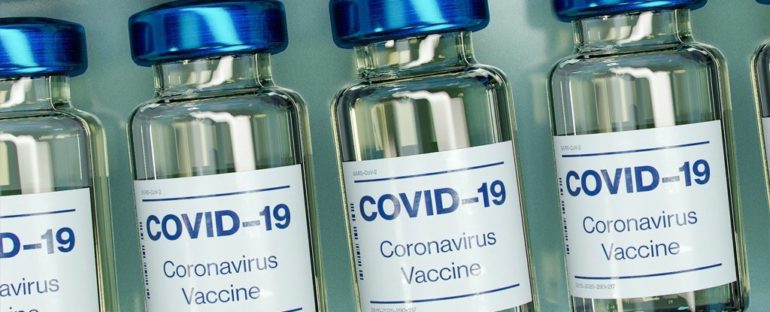We just took another big step forward in fighting the coronavirus pandemic.
Moderna on Monday said that its experimental vaccine was effective at preventing COVID-19, the disease caused by the novel coronavirus. The findings come from a massive and well-designed study, but they haven’t been reviewed by outside experts or by regulators.
The news comes just one week after Pfizer shared that its vaccine was effective in preventing COVID-19, sending markets soaring on the hope that an effective vaccine would help end the pandemic.
There’s a lot to keep in mind about what the results mean for the pandemic and for when Americans might be able to get a shot now that two vaccines have proven successful.
Here’s what you need to know.
1. Moderna’s vaccine is 94.5 percent effective
As of Moderna’s initial analysis of its late-stage, 30,000-person trial, its vaccine is 94.5 percent effective. Pfizer reported that its vaccine was more than 90 percent effective.
Those numbers may change as we get more data on trial participants who’ve gotten infected with COVID-19.
Even so, the results are better than many experts expected. Prior to Moderna and Pfizer’s announcements, Dr Paul Offit, a vaccine expert, told Business Insider he hoped to see a shot that reduced the chances of getting moderate or severe disease by 70 percent, adding that anything more than 50 percent would be valuable.
Vaccine effectiveness varies. Some, like the seasonal flu vaccine can be as low as 44 percent effective, while shots that prevent polio and measles are 99 percent and 97 percent effective, respectively.
Up next, Moderna plans to submit the vaccine to the Food and Drug Administration for emergency authorization. It’s waiting on key safety data before submitting.
2. Having two effective vaccines is great news for society
Stopping the spread of the novel coronavirus will require wide-scale vaccination efforts around the world.
Should the FDA authorise the vaccines made by Moderna and Pfizer, we will have a limited supply of shots at first.
Having two effective vaccines, however, should help increase distribution. Moncef Slaoui, the head of Operation Warp Speed, said he anticipates 20 million Americans will get coronavirus vaccines in December, if both vaccines are approved.
Dr Anthony Fauci, the director of the National Institute of Allergy and Infectious Diseases, on Sunday said he anticipates a return to “relative normal” in 2021 if the majority of Americans get vaccinated.
Both vaccines are given as two doses. Pfizer’s regimen is space out by 21 days, while Moderna’s second dose comes 28 days after the first.
3. The pandemic’s end could be in sight, but a vaccine’s impact won’t be immediate
Success on vaccines is reason for celebration. But it will still take many months to roll out a vaccine to everyone, and people need to continue wearing masks and social distancing.
The pandemic is raging across the US with surges in new cases, hospitalizations, and deaths. The shots are still experimental and the process to authorise a shot will likely take weeks, Peter Marks, the FDA’s director of the Centre for Biologics Evaluation and Research, told Business Insider in a November 13 interview.
“We all need to still be very focused,” Moderna CEO Stephane Bancel said, emphasising that masks and social-distancing are the best tools we have.
Bancel, for instance, said he won’t see his in-laws in Seattle or any friends for Thanksgiving, as he typically does.
“That’s just the price we going to have to pay to play our role so that we minimise the risk of contamination and we protect those who are at highest risk,” Bancel said in a Sunday evening interview.
4. Moderna’s vaccine can be stored in standard refrigerators for up to 30 days
Moderna’s vaccine won’t require a deep-freeze, unlike Pfizer’s shot.
Pfizer’s vaccine needs to be shipped and stored at negative 94 degrees Fahrenheit, a temperature colder than what’s needed to store most other vaccines. That can be challenging in the US and presents even more of an obstacle in some other countries.
Pfizer will ship the vaccine by air and land using dry ice, along with reusable GPS temperature-monitoring devices.
Moderna’s meanwhile can be stored using standard refrigeration for up to 30 days, the company said on Monday. That greatly simplifies the distribution challenge compared to Pfizer’s shot.
The shot is stable for a month at anywhere from 36 degrees Fahrenheit to 46 degrees Fahrenheit, which is the standard temperatures of refrigerators.
Moderna’s vaccine can also be stored for up to six months at -4 degrees Fahrenheit, a typical temperature requirement that hospitals and clinics are used to.
Pfizer is already working on a next-generation version of its shot that wouldn’t need to kept at extremely cold temperatures, the company’s chief scientific officer told Business Insider.
5. Moderna’s success signals that Pfizer’s vaccine results weren’t a fluke
Pfizer and Moderna both developed messenger-RNA vaccines, which require just the genetic code of the virus to engineer an experimental vaccine. Pfizer’s results in November were the first data from a large-scale study to indicate that the technology works in humans.
While it might not necessarily signal success for other coronavirus vaccines in development, it does mean that Pfizer’s success wasn’t a one-off incident.
The successful results from Pfizer and Moderna should also validate the target that all the frontrunners are going after. All these shots target the same portion of the coronavirus: its spike protein.
Finally, the findings are a huge moment for mRNA as a platform. Moderna is working on several other vaccine candidates for Zika, influenza, cytomegalovirus or CMV, and respiratory syncytial virus or RSV. Bancel said he now has greater confidence in finding success against other diseases.
“It’s copy and paste,” Bancel said. “So the Zika vaccine, the CMV vaccine, if this vaccine shows high efficacy, they are going to have high efficacy. It’s just science.”
6. All 11 severe cases of COVID-19 in Moderna’s trial happened in participants who received a placebo shot
Moderna noted in its release that it has recorded 11 severe cases of COVID-19 among trial participants.
All of the participants who had severe cases of COVID-19 were a part of the placebo arm, Moderna said.
This is the piece of data that excited Moderna’s CEO the most, Bancel said. While he emphasised these aren’t the final study results, the early findings mean “we might have a chance to prevent severe disease.”
That means they hadn’t received the experimental vaccine.
Moderna also broke down the 95 COVID-19 cases it documented by age and background. Among the cases, 15 were in adults 65 and older, and 20 participants who got COVID-19 identified themselves as being part of a diverse community.
7. Nearly 10 percent of participants experienced fatigue that was severe enough to interfere with daily life
Moderna’s vaccine comes with some notable side effects.
While most side effects from Moderna’s shots were mild or moderate, some volunteers did have severe side effects, which are medically significant but not immediately life-threatening.
These mainly happened after the second injection. Even so, the most common severe side effects were fatigue in 9.7 percent of participants, and severe muscle pains or aches, which occured in 8.9 percent of participants. Known as Grade 3 events, these are side effects so severe that they interfere with daily life or activities for a period of time. Moderna said they were mostly “short-lived.”
5.2 percent of participants experienced severe joint pain, 4.5 percent had bad headaches, 4.1 percent experienced injection-site pain, and 2.0 percent had redness at the injection site.
This article was originally published by Business Insider.
More from Business Insider:



